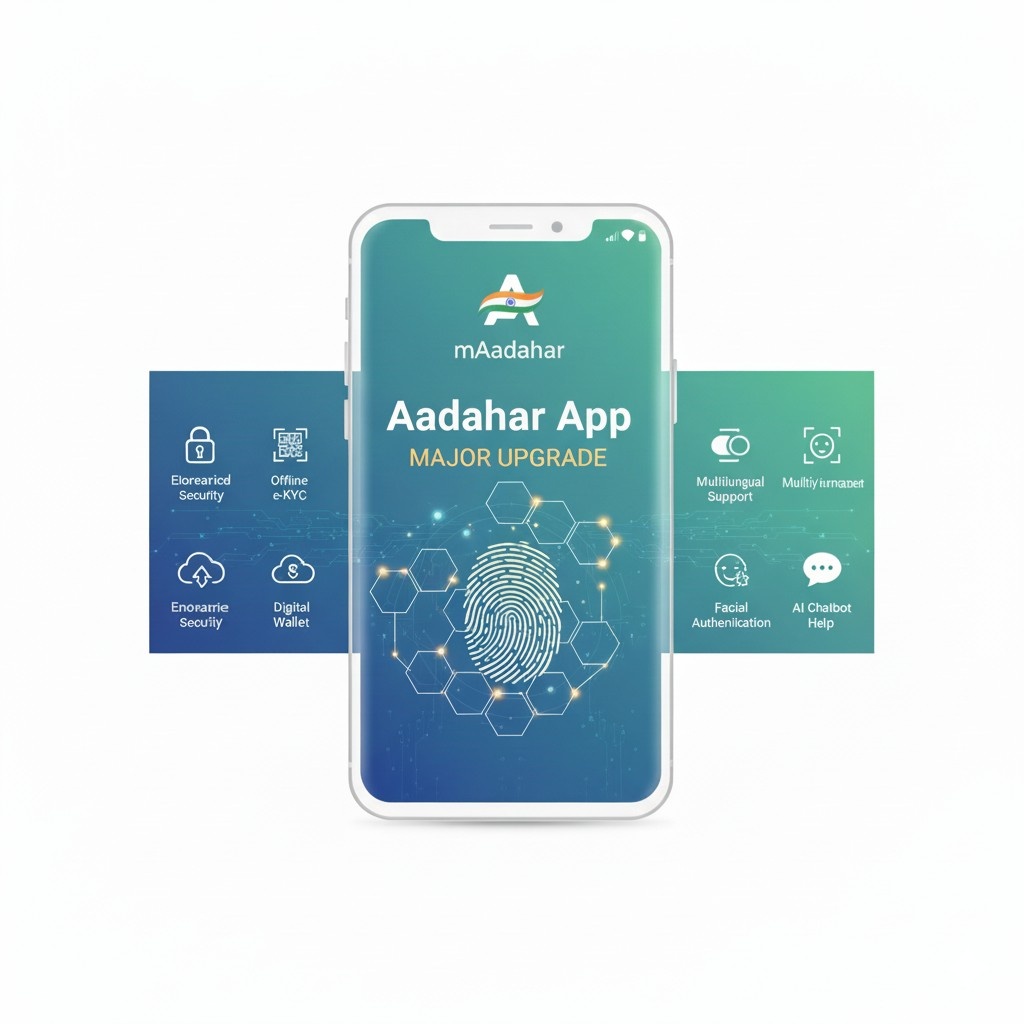India’s Aadhaar App Gets Major Upgrade: More Secure, More Flexible

India’s national identity scheme just entered a new phase. The UIDAI has launched a revamped Aadhaar App for both Android and iOS, allowing residents to carry their Aadhaar digitally, lock biometric access, manage multiple family profiles and share only the data they choose. For 140 + crore citizens, this means more convenience — and more control.
Background / Context
The 12-digit Aadhaar number and its associated card have been the backbone of identity verification in India for years.
Until now, the primary mobile interface was the older “mAadhaar” app, which allowed functionalities like downloading a digital Aadhaar, address updates and QR code generation.
With increasing digitisation of government, banking and everyday services, there has been a push for a smoother, more secure way to carry and share identity — without always relying on physical documents or full disclosure of all personal details.
Key Developments / Details
The new app (simply called “Aadhaar” in the stores) brings several headline features:
Face authentication and biometric lock: During setup, users must authenticate via a face-scan after verifying their registered mobile number. A biometric lock option ensures fingerprints/iris recognition remain locked unless unlocked by the user.
Multi-profile support: Users can add up to five Aadhaar profiles (for family members) on a single device — provided all these profiles share the same mobile number as the primary Aadhaar.
Selective sharing & QR code based verifiable credentials: The app allows users to share their Aadhaar for verification in a “verifiable credential” format. They can choose to mask certain fields (e.g., only show name and photo, hide address and date of birth). QR scanning of Aadhaar-related codes is also supported.
Offline access for verification: Once set up, the app lets you use it for verification even when you are offline — for example by scanning or showing QR codes — though full feature access still needs connectivity.
Clarification on coexistence: The new app does not immediately replace the older mAadhaar app; the older app still retains features like address update, PVC ordering, etc.
Technical Explanation
Think of your Aadhaar card as a digital passport held in your phone. In the new app:
The face scan acts as a gatekeeper — ensuring that even if someone has your phone, they can’t just open the app.
The biometric lock is like putting a safe around your fingerprint/iris login — you can disable it but by default your biometrics are locked.
Multi-profiles: Imagine you’ve got one master key (your mobile number) and 5 lockers inside (family Aadhaar profiles). If your parents or children share your mobile number in the Aadhaar database, you can add their profiles, but only links tied to that number.
Sharing only necessary details: Instead of handing over the whole passport, you give a masked copy — say just your name and photo — when verifying to someone who doesn’t need your full address or DOB.
Offline mode: Once the digital card is securely stored, you can still present it even if there’s no internet — like carrying a printed copy — but updates/changes/online sharing still need connectivity.
Implications
For regular users:
Carrying a physical Aadhaar card becomes optional — you can present your identity via the phone.
More privacy control: You decide how much data to share in a transaction.
Easier for families: Those with shared mobile number can manage profiles in one place.
For service providers & industry:
Verification processes in banking, telecom, insurance, government services may become smoother as QR-based or verifiable credential workflows replace paper/photocopies.
Reduced dependency on physical document handling and potential for faster onboarding.
For society/governance:
Moves closer to a paper-less identity ecosystem, which supports digital inclusion and streamlined service delivery.
Raises the bar for identity security and privacy protection at scale across India.
Challenges / Limitations
The app still requires the mobile number to be registered with the Aadhaar number — if your Aadhaar is linked to a different number or you don’t have access to the number, setup may be blocked.
While offline viewing is supported, full functionality (updates, sharing, new registration) still demands internet.
Users who do not share mobile numbers with family members may not be able to add those profiles under one device.
Important: The app does not currently replace the older mAadhaar in terms of all services — features like changing mobile number, full demographic updates may still need enrolment centre visits.
Security & privacy concerns: Centralised digital IDs always invite scrutiny — the robustness of backend authentication, data protection and how easily the app can be mis-used will be closely watched by privacy experts.
Future Outlook
Expect the UIDAI to gradually phase in more online update capabilities (e.g., mobile number change) via the new app.
Service providers (banks, telecoms, government portals) will likely integrate the verifiable-credential and QR-based Aadhaar workflows, making onboarding faster.
With wider adoption, the app might support more advanced features — e.g., authentication for access to services, automatic updates, offline verifications across states, child Aadhaar profiles etc.
For users, this could mark a shift: your phone becomes your primary identity wallet — which underscores the need to protect that device, the mobile number registered, and your screening of shared data.
Conclusion / Summary
The new Aadhaar App is more than just another app update — it represents a meaningful step toward a more secure, flexible and user-centric digital identity system in India. While it doesn’t eliminate all the old workflows just yet, it gives users a better, easier way to carry and share their Aadhaar. For anyone holding an Aadhaar number, this is one tech-upgrade worth installing and exploring.